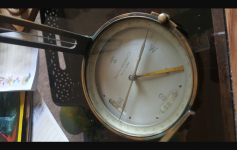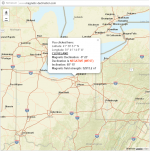Why can't you do that at home?
One could, and some do. The problem would seem to be that one has to make a permanent choice of 'group entertainment' positioning or 'single serious listener' positioning. In that case some will choose the latter option, as not to have it readily available would be unthinkable. Maybe when it becomes economically feasible to have very solid robotic speaker positioning, then someone could choose to have it both ways. In other words, probably not in my lifetime.
Well the best venues (like my back deck) don't have sound reinforcement systems. For those that do, and where they put the speakers on the stage, are they typically using conventional stereo? Or is it more like dual mono? Either way, I have heard live orchestras in good venues, and localization cues are much less impressive than in a decent home stereo. Listen to a string quartet live in a small venue, alk acoustic, close your eyes and point at the viola. You can't do it unless they are sitting unnaturally far apart or you are sitting unnaturally close. But it's easy with a decent stereo. Illusion is so much fun!
When it comes to a stable stereo image as one moves around a normal room, omni and dipole speakers do a very good job. Linkwitz did a good job of explaining this.
When it comes to a stable stereo image as one moves around a normal room, omni and dipole speakers do a very good job. Linkwitz did a good job of explaining this.
Ooh,ooh, Mr. Kotter, Mr. Kotter....I got this!!
Because the stage won't fit in the home??
Seriously though, the discussion is about soundstage, how the system can fool us into "seeing" the sounds spacially.
That must be distinguished from fidelity.
For me, a good system is capable of supporting the imaging even if I am not directly on axis. While the source ITD is fixed relative, ILD off axis throws perception around a bit. Some thing are done to compensate, such as horizontal dispersion characteristics and toe in/out.
But eventually, the farther off axis you get, the image elements will shift relative to the central image source, and frequency dependent localization as well such that the image breaks up.
Humans...go figure.
Jn
1st off, you get the prize for being the first to quote 'Welcome Back Kotter!'
And this off-axis lobing issue was (sort of) solved a long time ago...:
HHR Exotic Speakers - History
But seriously, I worked at a stereo store that had a pair and sometimes I loved them...other times not so much...the many reflections combining with the direct sound made them program and placement dependent.
But one thing was for sure, after placing absorption behind them, there was a very wide sweet spot. Memories......I could never afford them but ended up buying a pair of Ohm Ls which are still in my family and sounding just fine...Playtex glove surround replacement and all.
Cheers!
Howie
There is thing called reverberation. In a live sound venue 2/3 of the folks are getting more from the reverberant field as opposed to the direct field typically.
Notice that, with my horns at home, If I cross them a little more than facing the central listener, and because its directivity, the image stay quite in the center, even if you move a little. More level from the opposite speaker and less from the closest when you move aside). Enough for 3 people.For me, a good system is capable of supporting the imaging even if I am not directly on axis. While the source ITD is fixed relative, ILD off axis throws perception around a bit. Some thing are done to compensate, such as horizontal dispersion characteristics and toe in/out.
But "serious listening" if often a solitary pleasure. By luck, this position of the speakers help to get a slowly descending response curve that makes a more natural reproduction.
Last edited:
Yay,I win😀1st off, you get the prize for being the first to quote 'Welcome Back Kotter!'
Course, WKRP was my fave, the "dialogue" was fantastic..😱
Jn
But it seemed it was sort of a game to map out where their instruments didn't work. (Cuba?)
Most probably, cold war scenario (mapping interference on radio navigation)
It showed the due South was North.
Large steel structure nearby which was strongly magnetized (post welding MPI crack inspection)?
BTY my great uncle's last project was to help layout the borders of Israel.
1948, 1967, 1994?
I did learn a bit about surveying from him!
1919 Keuffel & Esser Preliminary Survey Transit - the homepage of Nicolàs de Hilster, PhD
George
Attachments
George,
Flying crazy for boredom relief, not an assignment.
1948 and that is pretty close to the compass.
Nearby steel would have been the ballpark!
Flying crazy for boredom relief, not an assignment.
1948 and that is pretty close to the compass.
Nearby steel would have been the ballpark!
Nearby steel would have been the ballpark!
Large structures (and large steel structures) affect even the local acceleration of gravity (beyond the forth decimal point).
Usually national geophysical labs have to be contracted to provide such a measurement.
It is one of the parameters that a Cal Lab should have determined when claiming mass or pressure cal capabilities with a small uncertainty error.
George
Large structures (and large steel structures) affect even the local acceleration of gravity (beyond the forth decimal point).
George
George, in the 50's if you took a car trip around the countryside the were these "Secret Spots" where they would charge you 50 cents to walk on an apparently flat platform where you felt off balance or uneasy. Some claimed that the local G was that far off due to enormous non-uniformity of local geology. I still think it was mirrors, etc. 😀
There is thing called reverberation. In a live sound venue 2/3 of the folks are getting more from the reverberant field as opposed to the direct field typically.
Therefore my own (and others here) preference for near-field monitoring to minimize the contribution of the room when I want to do critical listening.
Otherwise...old tube AM car radios and speaker with sun-cracked cones are where it's at...old Motown sounds great in that environment (only slightly kidding...).
Howie
Otherwise...old tube AM car radios and speaker with sun-cracked cones are where it's at...old Motown sounds great in that environment (only slightly kidding...).
... has to be a big boat style convertible with the roof down though. 🙂
This was a favourite haunt when I lived in Brum, drinking generally helped with stability 🙂 The Crooked House - Wikipedia
I still think it was mirrors, etc. 😀
Don’t ask.
Last week in a tour with my wife, when rolling downhill in neutral (manual gearbox) in a place in southern Peloponnese, the car was decelerating. I had to pull over to check the car and the tires, no issues.
I’ve heard of such strange places but never had personal experience before.
I went for a drink afterwards😀
The requirement for determining the "local g" I wrote above was a flash back from circa 2001. In the cal lab we maintained a Ruska pressure balance [Edit: three Ruska pressure balances] as the primary standard for pressure. Among other things it was used to calibrate Air Data Computers.
At that time, the RVSM Reduced vertical separation minima - Wikipedia was put in effect here and we had to reduce the uncertainty error of pressure values.
The procedure and the equations were in the Ruska manual, I found a relevant link (oh, the Internet). https://nvlpubs.nist.gov/nistpubs/Legacy/SP/nistspecialpublication250-39e2009.pdf
George
I have received and plugged those little wireless Keff LS50.
Amazing little speakers for their size.
Perfect to watch TV and easy listening of music. Exactly what I was looking for.
Amazing little speakers for their size.
Perfect to watch TV and easy listening of music. Exactly what I was looking for.
Okay, those were interesting responses to my post about venue sound in the home.
I attend a couple music festivals ever year. The venues are open air or in tents. Not much reverb there. I find the sound at the festival venues to be pretty good.
However, most of my listening is to classical music. And I also go to concerts, in big concert halls and small art gallery rooms. One hears the musical instruments at concerts not a venue sound system. While some people do have differing views on preferred seating at symphony concerts, there is generally excellent sound over a large amount of the seating area in the hall.
So, given the consensus of opinion that venue sound sucks compared to home sound, does that same opinion also hold for classical music venues?
Of course classical music has been falling in popularity for decades and I realize I am one of the few who listens to the music at home and also goes to concerts.
I attend a couple music festivals ever year. The venues are open air or in tents. Not much reverb there. I find the sound at the festival venues to be pretty good.
However, most of my listening is to classical music. And I also go to concerts, in big concert halls and small art gallery rooms. One hears the musical instruments at concerts not a venue sound system. While some people do have differing views on preferred seating at symphony concerts, there is generally excellent sound over a large amount of the seating area in the hall.
So, given the consensus of opinion that venue sound sucks compared to home sound, does that same opinion also hold for classical music venues?
Of course classical music has been falling in popularity for decades and I realize I am one of the few who listens to the music at home and also goes to concerts.
Last edited:
Which is why I like to buy them from the drivers seat.However, when it comes to cars, beauty is in the eye of the beholder.
Me too. I can sometimes match the manufacturers mileage rating and my tires last more than 100k kms.I’ve given up trying to race around.
Just call me Granny.
And Bill, my tires are 19's and 20's. 🙂
- Status
- Not open for further replies.
- Home
- Member Areas
- The Lounge
- John Curl's Blowtorch preamplifier part III

